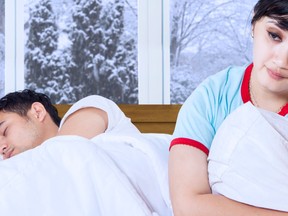Do separate beds make for happier couples? A look at the research behind this growing trend and other sleep aids

Recommended Videos
Sleep scientist and psychologist Wendy Troxel prefers “sleep alliance” over “sleep divorce” as the preferred way to brand the growing trend of couples opting not to bed-share. Divorce carries a negative overtone that suggest sleeping apart is a sign of a dysfunctional — sexless or loveless — relationship.
“Now, how judgy is that,” Troxel said in a TEDX talk. Studies suggest that when poorly slept, people are more prone to engaging in behaviours that aren’t great for a happy union largely due to disrupted “emotion regulation,” Troxel and other sleep researchers have reported.
Here’s what the science says about sleep divorce, sleep trackers, the 10-3-2-1-0 rule and other strategies people are trying to deal with sleep problems.
Do separate bedrooms make for happier couples?
On TikTok, videos related to #married couples/separate rooms have become among the most viewed. “My husband performs what I can only describe as a crocodile death roll every time he needs to move in bed,” one woman shared.
Other research suggests poor sleep increases a couple’s inflammatory response to marital stress.
Author of Sharing the Covers: A Couple’s Guide for Better Sleep, Troxel said a sleep alliance can also be achieved using earplugs, white noise machines, separate bedding “to quell sheet-stealing” or other approaches that don’t necessarily require separate beds or rooms.
How reliable are sleep trackers?
Wrist-worn or ring-worn devices combine information from limb and body movement, heart rate and temperature sensors that purport to measure total sleep time, total wake time and sleep efficiency. They’re far less cumbersome than lab-based sleep studies that use a technique called polysomnography to record brain waves, blood oxygen levels, eye activity and other metrics to distinguish between “awake” and “asleep,” and how much time is spent in different sleep stages.
However, the proliferation of wearable sleep trackers has come with little third-party validation of claims.
All in, total sleep time, total wake time and sleep efficiency were measured with greater accuracy by Fitbit Ionic and Oura smart ring, “whereas all other devices demonstrated a propensity to over or underestimate at least one if not all of the aforementioned sleep metrics.”
All of the devices struggled to accurately quantify sleep stages, including deep sleep, which the authors said wasn’t surprising given the most accurate way to assess sleep stages is via electrical signals from the brain from EEG.
Still, “understanding current sleep habits, from the average time you go to bed and wake up, to the average amount of time you are awake in bed, can be enlightening” and potentially used to better one’s health, the researchers said.
Sixty-three people were fitted with actigraphy devices that measure cycles of activity versus non-activity. Those given a “negative” sleep score upon wakening reported being less alert, moodier and sleepier during the day than those given a positive score, even though both groups got the same amount and same quality of sleep.
The findings could have implications for sleep trackers that claim to measure “objective” sleep but provide inaccurate data compared to gold-standard equipment, the authors said. “Inaccurate feedback about sleep may affect hundreds of thousands of people every day, globally, driving biases in the appraisal of daytime function,” they wrote. And while they focused on people with insomnia, wearable trackers or under-mattress sensors might risk making decent sleepers poor sleepers.
What’s the 10-3-2-1-0 formula?
Ten hours before bed, no caffeine (it takes roughly that time for the effects of caffeine from your last cup to wear off). Three hours before bed, no food or alcohol (alcohol is associated with lighter, lower sleep). Two hours, stop working. One hour, turn off all screens and wind down; engage in something relaxing, like reading, meditating or brushing your dog. Zero, the number of times hitting “snooze” in the morning.
Other studies recommend no napping, because naps can reduce the homeostatic drive for sleep at night, avoiding sleeping in on weekends (body and brain prefer a regular sleep-wake schedule) and waking every day at the same time. A consistent wake time means consistent “first time to light exposure,” psychiatrist and sleep medicine specialist Dr. Michael Mak told a virtual audience as part of a Canadian Sleep Society lecture series. Morning light exposure stabilizes the internal body clock, leading to better daytime mood and better sleep at night.
Try to avoid ruminating about the past, the future, something said or not said, when trying to fall asleep. Mak suggested thinking about your favourite fruit: “the texture, the skin” — mundane things that replace stressful things. Research has also shown that weighted blankets, that sensation of being swaddled like a baby, activates the parasympathetic nervous system, calming heart rate and breathing.
Another way to lower heart rate? Avoid reaching for a smartphone when waking in the middle of the night. “And what do (people) do? ‘Let’s see what’s on Facebook. Have I gotten any messages? Maybe I’ve gotten an email from my boss.’ There is no universe where you need any of that information in the middle of the night. There’s none. There’s none,” psychologist and clinical sleep specialist Dr. Michael Breus said in a Quartz podcast.
“It’s the engagement we want to avoid.”
National Post